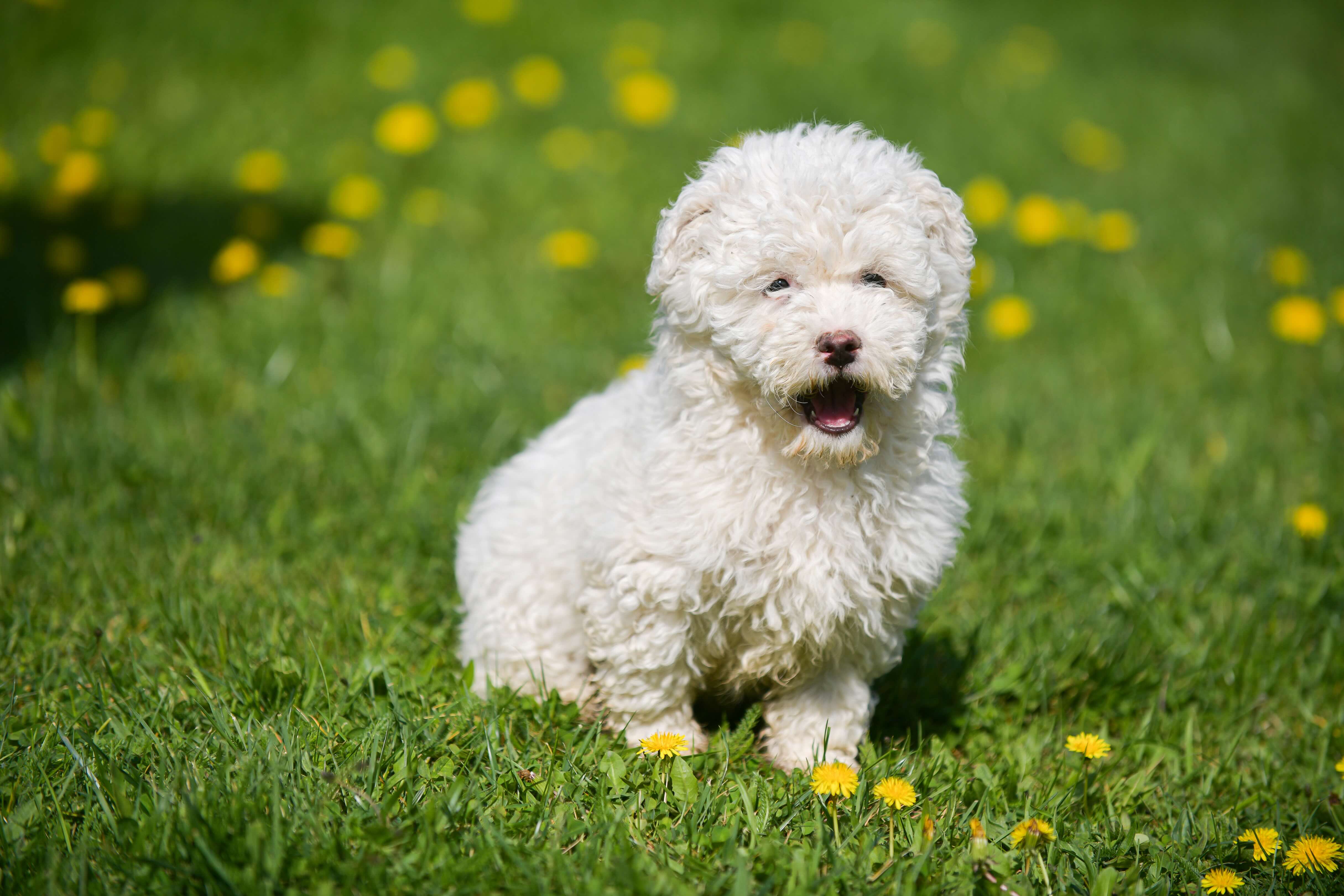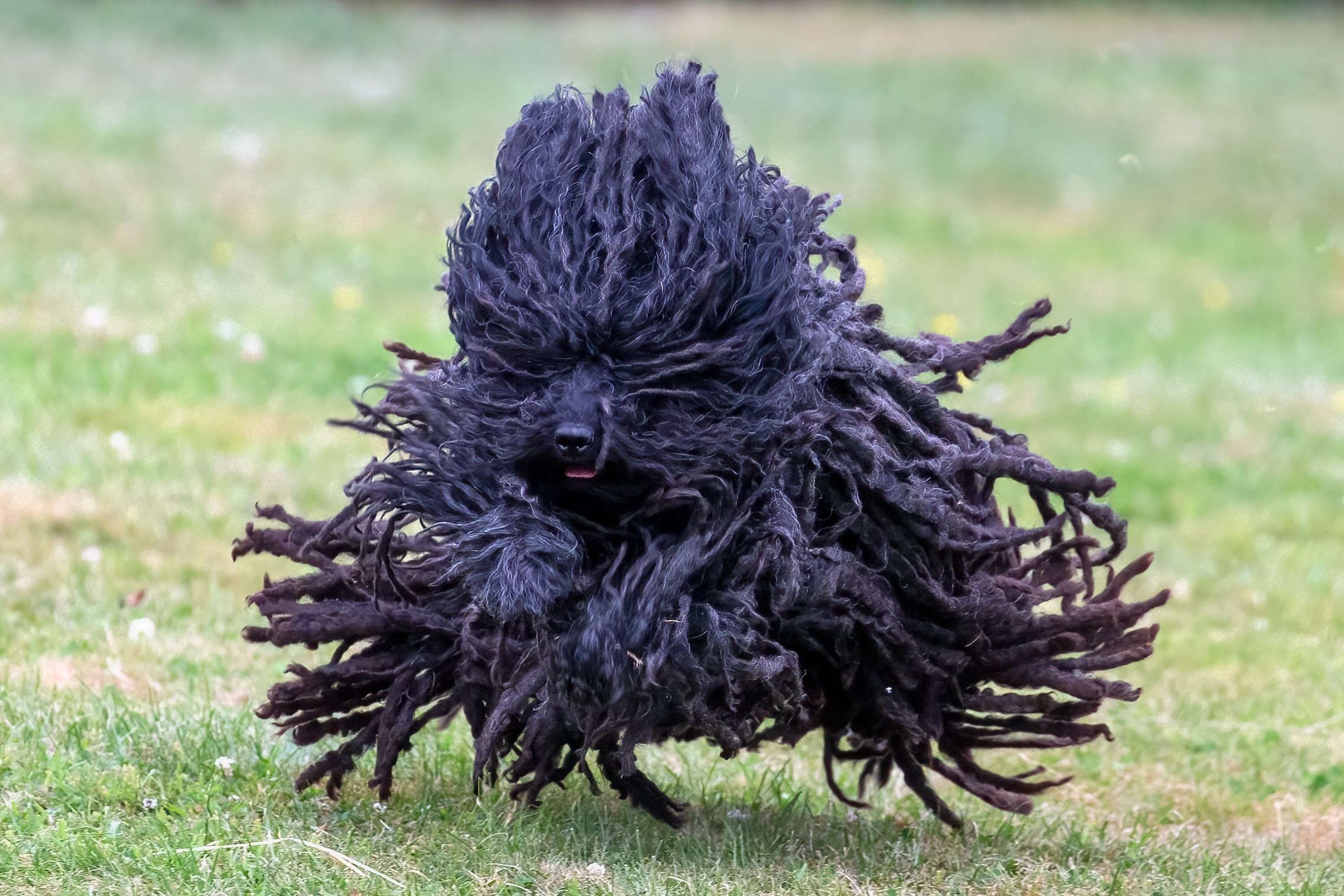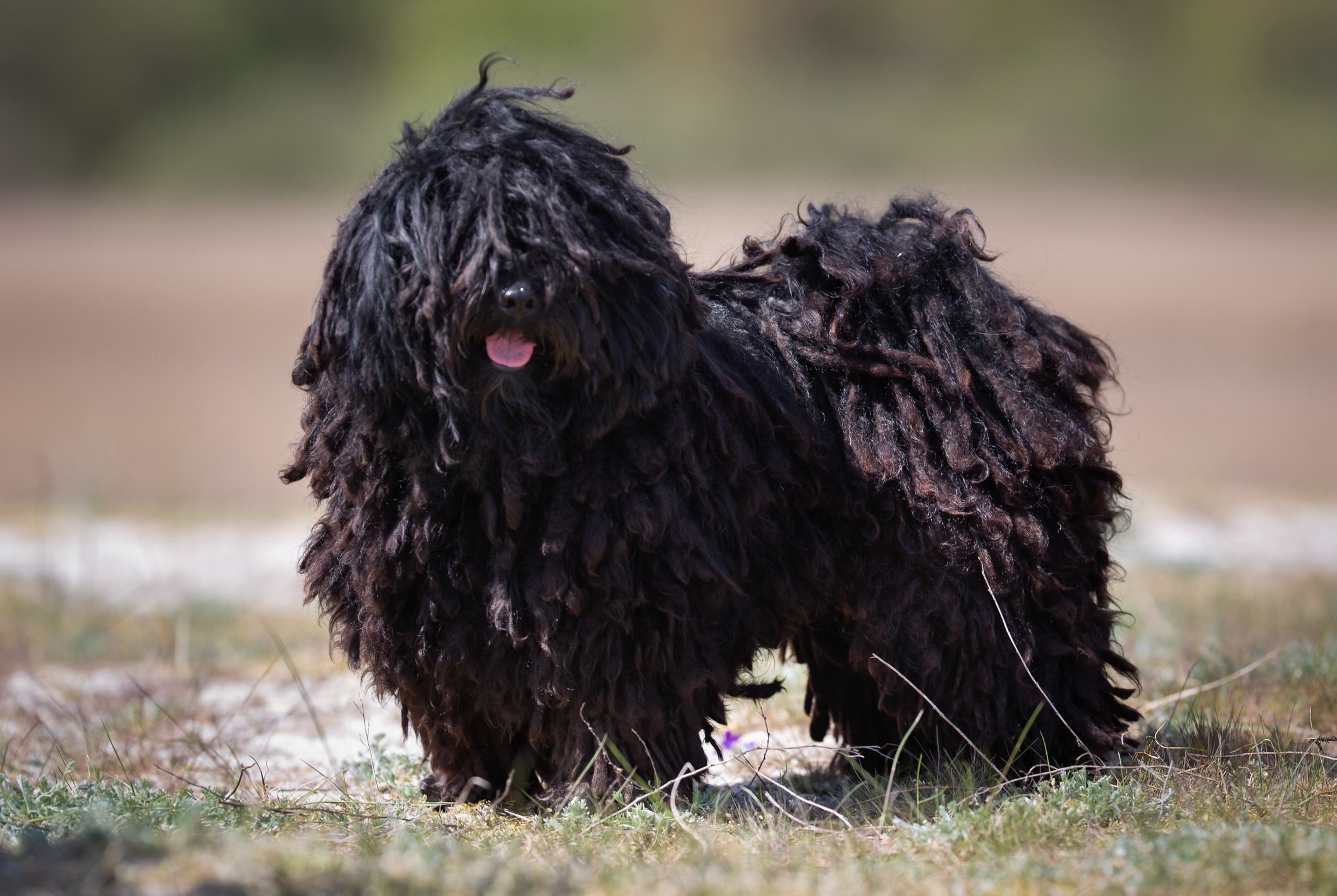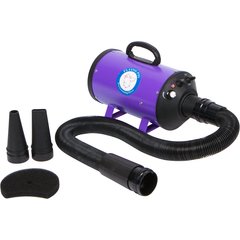Puli
Adobe Stock/Victoria
The Puli is a medium-sized dog breed best recognized for a long coat of cords. Pulik (the plural form of Puli) originated in Hungary as herding dogs and guardians, and the breed is thought to have descended from Tibetan Terriers that were brought to Hungary in 900 CE.
Puli dogs are smart, affectionate, and bonded to their family. Full-grown Pulik stand 16–17 inches tall and typically weigh 25–35 pounds. They have an average lifespan of 10–15 years.
Caring for a Puli
As a herding dog, the Puli is a smart dog that needs exercise and mental stimulation to be happy. When left to their own devices, a bored Puli may bark a lot. They need at least one hour of activity every day.
Pulik do not shed, but they require daily grooming to manage their cords. Their very dense corded coat can cause them to overheat, so be careful during hot weather and ensure they always have access to fresh water and shade. Additionally, their coat becomes heavy when wet, so pay close attention if your Puli goes for a swim.
Puli Health Issues

Pulik are generally a healthy breed without a lot of issues. But like all dogs, Pulik can develop a few health conditions.
In addition to these, all dogs are at risk of injury and illness. Purchasing pet insurance may help cover expensive medical needs.
Hip Dysplasia
Hip dysplasia is a genetic disease characterized by a loose hip joint that causes the cartilage and bone to wear down. This can cause osteoarthritis, and arthritis leads to pain, limping, and difficulty standing.
Veterinarians often recommend low-intensity exercise and joint supplements for dogs diagnosed with hip dysplasia. When pain is present, non-steroidal anti-inflammatory drugs (NSAIDs) or a monoclonal antibody injection like Librela are frequently prescribed.
Surgery may be recommended in severe cases of hip dysplasia.
Patellar Luxation
In dogs with patellar luxation, the kneecap slips out of its proper groove. This causes discomfort and, like hip dysplasia, can lead to arthritis. One common sign of patellar luxation is a bunny-hopping gait, in which an affected dog will skip on three legs.
The knee can realign on its own in some cases, but supplements, anti-inflammatory medications, or pain-blocking injections are required for some dogs. In severe cases, your veterinarian may recommend surgery.
Progressive Retinal Atrophy
Progressive retinal atrophy (PRA) is a group of diseases that causes the rods and cones on the eye’s retina (the light-sensitive tissue at the back of the eye) to break down. Difficulty seeing in the dark is often the first sign, but over time PRA progresses to blindness.
PRA is an inherited disease in most cases, and there are currently no effective treatments. Talk to your vet if you notice changes in your dog’s eyes or vision.
Degenerative Myelopathy
Degenerative myelopathy (DM) is a neurologic disorder that affects the spinal cord. The first signs are weakness in the hind end, and the dog may have difficulty rising. Eventually, the weakness progresses into paralysis in the hind legs.
There is a DNA test for this condition, and affected Puli dogs should not be bred. There is no cure for DM. Management involves physical therapy, and acupuncture can also be helpful to slow the progression.
What To Feed a Puli

A good way to ensure your Hungarian Puli receives a complete and balanced diet is to offer food approved by the Association of American Feed Control Officials (AAFCO).
Puli puppies need a diet formulated specifically for puppies or designated for all life stages. When they’re around 1 year old, Pulik should slowly transition to adult food.
How To Feed a Puli
Pulik do best with two measured feedings per day. Puli puppies should be fed roughly three meals per day on a regular schedule to help maintain stable blood sugar and avoid hypoglycemia.
How Much Should You Feed a Puli?
The recommended caloric intake for a Puli dog varies between individuals and is based on your specific dog’s size, metabolism, health, neuter status, and activity level.
The feeding guide labels on your dog food packaging provide information on portion sizes based on your dog’s weight. However, the best way to determine how much to feed your dog is to talk with your veterinarian, who can calculate your dog’s caloric needs based on their lifestyle and health.
Nutritional Tips for Pulik
Pulik require a balance of carbohydrates, proteins, and fats to stay healthy and in a good body condition.
At your vet’s recommendation, Pulik may benefit from the addition of omega-3 fatty acids into their diets (found in skin and joint supplements, fish oil, and in some specially formulated dog foods). These fatty acids act as natural anti-inflammatories that help support the Puli’s skin, coat, kidneys, joints, and heart.
Behavior and Training Tips for Pulik
Puli Personality and Temperament

The Puli’s history as a herder and guardian has a big impact on the breed’s temperament. According to the Puli Club of America (PCA), the breed is intelligent and loyal to their family members but can be reserved around new people.
When properly introduced, most Pulik are patient with young children who know how to interact with dogs. However, Puli dogs need to learn that kids aren’t to be herded (which they might try to do).
Puli Behavior
The Puli dog breed is active, intelligent, and playful, according to the PCA. Because of their herding instincts, they may try to round up children or small animals, and they can bark excessively if they’re allowed to grow bored.
Puli Training
Pulik are smart and eager to please their family. This combination makes training easier than in some other breeds, although some Puli dogs can be more independently minded.
These playful dogs will learn best through training games and positive reinforcement methods. Begin training when your Pulik puppy is young and continue working on cues throughout their life.
It’s also important to socialize your puppy from a young age so they learn to be comfortable and confident around new people. Pulik were historically farm guardians, so without socialization they might be wary of strangers.
Fun Activities for Pulik
Puli Grooming Guide

Most adult Puli dogs have a long, corded, double coat that comes in colors including black, silver, and white. These cords are dense and grow naturally, and they require extensive care from the pet parent.
Coat Care
Puli puppies are born without their characteristic cords. When your pup is just under a year old (typically 8–10 months of age), their fur will begin clumping together and feel thicker to the touch.
These clumps need to be separated by hand and turned into distinct mats. You may need to do this repeatedly over the next year as the mats turn into longer, tighter cords. However, the PCA says some Puli dogs have fur that cords easily on its own.
Pulik should be bathed as needed. After bathing, pay special attention to the dog’s cords. You’ll need to squeeze excess water out of the cords; do not rub the fur dry with a towel.
Skin Care
After your Puli goes for a swim or takes a bath, it’s important that their fur is dried completely with a fan or blow dryer. Moisture that becomes trapped between the dog’s cords can cause mildew and skin infections.
Eye Care
Pulik don’t require special eye care, but because the breed is susceptible to PRA, contact your veterinarian if you notice changes in your dog’s eyes (such as discharge, cloudiness, or squinting).
Ear Care
Clean your dog’s ears regularly with a veterinary-approved cleaner to prevent ear infections; ask your veterinarian how often to do this. Talk to your vet if you notice signs of an infection, such as ear odor or debris buildup.
Care should be taken when managing the cords on a Puli’s ears, as the ears are sensitive and the skin is thin.
Considerations for Pet Parents
Pulik typically make great pets and become closely attached to their family. They have a history as watchdogs, so they may bark to guard their home or family. Mental and physical activity is important for the Puli and may limit barking.
While Puli dogs do not shed much, daily care is needed to manage their cords. Due to the Puli’s thick, double corded coat, pet parents need to be careful that their pup doesn't overheat.
Puli FAQs
Are Pulik good pets?
Yes, Puli dogs can be a good fit for families who provide them with mental stimulation, exercise, and early socialization.
Do Puli dogs naturally have dreadlocks?
Pulik naturally form mats that can be hand-shaped into long cords that resemble locks. When they are puppies, they have a soft coat that does not form cords until they’re 8–10 months old. These cords tighten up with time.
How rare is a Puli?
Pulik are rare in the United States. This may be related to their extensive grooming needs. The American Kennel Club (AKC) ranked the Puli as the 164th most popular breed out of 200 dogs in 2023.
How much do Puli dogs cost?
Purchasing a Puli puppy from a breeder can cost $1,000 to $3,000. Dogs of certain lineage may cost more. You may also be able to adopt a dog through the breed club’s Puli rescue organization.


